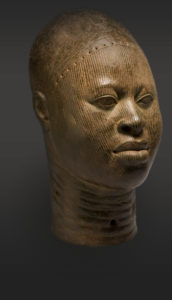 Went to see a wonderful exhibition recently at the British Museum called Kingdom of Ife – Sculptures from West Africa. It was a collection of beautiful sculptures, mostly heads like the one pictured, done in bronze, copper and terracotta, and dating from as far back as the 12th century.
Went to see a wonderful exhibition recently at the British Museum called Kingdom of Ife – Sculptures from West Africa. It was a collection of beautiful sculptures, mostly heads like the one pictured, done in bronze, copper and terracotta, and dating from as far back as the 12th century.
The exhibition made me realise how ignorant I am about African history. I’d never even heard of the Kingdom of Ife, which flourished in modern-day Nigeria from the 12th to the 15th centuries. I have a history degree from Oxford University, but never learned anything about African history beyond the 19th century colonial “Scramble for Africa”.
The regular African collection at the British Museum is also pretty unimpressive compared with this special exhibition. It’s housed in the basement (far away from the Egyptian collection, which is one of the museum’s highlights, but Egypt is apparently not in Africa for the British Museum’s purposes). As I can remember, it consists mostly of masks and wood carvings no more than a century or two old. There was nothing in there that really grabbed me in the way that these much earlier Ife sculptures did.
So I’d highly recommend going to see this exhibition – it’s on until 6 June 2010. As well as the sculptures themselves, there’s excellent information about the society and its beliefs, and about the process used to create the sculptures (the “lost wax” method of bronze casting). I can’t remember the exact details, but it was something like creating the sculpture in clay, then coating it in wax, then creating a mold, and heating it up to melt the wax and drain it away through little tubes, leaving space for the molten bronze to be poured in and form the shape of the mold. I’m not explaining it well, so you’ll have to go and see for yourself!



There are 5 comments
Thanks for the recommendation I’ll be sure to go see this. If never heard of it either and it sounds like a great thing to go and see!
I enjoyed your art review. In Zimbabwe there is a great fortified town called the Great Zimbabwe, which was more than a fortification. Recent archaeology also shows that a great civilization occurred there. There are smaller Zimbabwe fortifications all around the country.
Africa is so vast and diverse. And, archaeology has only recently been carried out I believe to study Africa’s African past.
I agree with you that Egypt is part of Africa. Queen Ty is one of my favorite queens. She was a Sudanese (?) slave who rose to become queen of Egypt. There’s a great sculpture I saw of her. She’s much more interesting to look at than Nefertiti I think.
Sorry I don’t have all my sources and citations, but it’s early over here in the states. 🙂
Best,
Ruth
Hi Ruth,
Thanks for the recommendation – I’ll find out more about Queen Ty. I think for a long time those Zimbabwe fortifications were seen as evidence of former European presence in Africa, because the European explorers couldn’t believe they had been built by Africans. There was a similar story at the Kingdom of Ife exhibition – the German archaeologist Leo Frobenius, when he discovered the amazing bronzes, assumed he had found the lost city of Atlantis. Again, the assumption was that Africans couldn’t have done something so beautiful – he had to link it to European classical antiquity. I think this sort of thing is what has held back a lot of our understanding of African history.
Hi Charles,
Hope you enjoy the exhibition! Do let me know what you think of it. Thanks for the comment.
Hi Andrew,
Benin has a long history of Bronze sculpture as well. I saw an amazing show in Paris at the Foundation Dapper all about the sculpture of Benin once. They gave the same explanation that you did that the Europeans did not believe that the Africans could create this kind of work.
There’s a great, unknown museum in the United States in Hampton, Virginia that is dedicated to African and African-American art called the Hampton Museum – very original. Anyways, they have West African ancestor chairs that gave them the right to rule – sounds like a coronation throne, doesn’t it. “Medicine man” costumes – don’t know what these should righly be called. I love art that makes me think differently and opens the way to understanding other cultures.
Well, I could go on forever on this topic. Don’t want to jabber without reason…
Ruth 🙂
Have you ever read Ryszard Kapusinski’s The Emperoror or Imperium. They are non-fiction and fit in well with your interests in dictatorship. Ruth 🙂